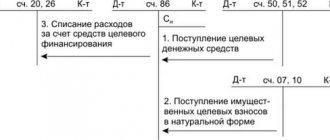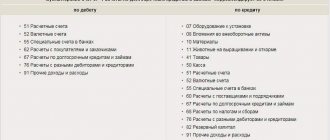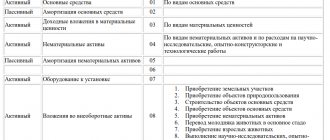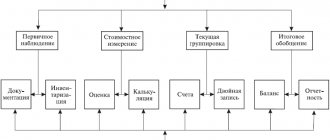- home
- Investments
Anastasia Osipova
Updated: February 3, 2021
0
Article navigation
- Long-term investments in accounting
- Regulations on accounting for long-term investments
- Accounting for long-term investments: postings
- Typical wiring
- Organization and procedure for accounting for long-term investments
Long-term investments are the company's costs for the creation and acquisition of non-current durable assets that are not intended for sale. As sources of their financing, the enterprise’s own funds (net profit, amortization of intangible assets) and attracted funds (bank loans, borrowed funds from other organizations, targeted financing from the state budget, etc.) can be used.
In accounting, financial investments are considered as an independent object along with fixed assets and intangible assets. This approach is associated with the concept of separating costs between the company’s current activities and investments. The main purpose of accounting is to fully reflect information about long-term investments. If we consider the accounting of financial investments briefly, we can say that this is an influx of new capital in the reporting year.
Basic terms, types of investment funds
So, investment funds include institutions that engage in collective investments, managing the savings of individuals and legal entities, investing them in the purchase of securities. This activity is carried out by a professional stock market participant who, thanks to his knowledge and experience, is able to minimize investment risks.
There are several types of investment funds. First of all, these are mutual investment funds (UIFs), whose activities are based on joint investment.
They also include: the Russian investment fund, which acts on behalf of the state; mutual funds, which is a form of mutual investment; hedge funds - which are not available to everyone, there are no regulatory restrictions on them and they are managed by professional investment managers; There are also checking investment funds and exchange traded funds.
It is worth considering in more detail a mutual investment fund (UIF), which in order to carry out its activities (trust management of fund property) is not required to form a legal entity, while it is formed from the funds of shareholders-investors. Trust management is carried out by a special management company.
Structure
Own funds - profit and deductions for depreciation of objects.
Raised funds - borrowed funds (budgetary and extra-budgetary), bank loans, investments of business partners (both Russian and foreign).
| Sources of financing | Ways to attract financing | Factors influencing the size of investments |
| Resources of business owners | Profit, depreciation, resources of members of joint-stock companies (increase and revaluation of shareholders' shares) |
|
| Government resources | Budgetary and extra-budgetary revenues |
|
| Borrowed funds | Bank loans Loans from foreign partners Other investments that need to be repaid |
|
| Other sources | Leasing Venture funds Factoring and forfaiting |
|
Another important parameter is the structure of investment activity. IOCs include:
Accounting for types of financial assets. Type of economic activity. Taking into account funding sources. And also taking into account economic activity.
If we consider the percentage distribution of PF, statistical data on average from 2000 to 2021 fluctuates around the given figures:
- In housing – about 13% on average.
- In buildings and various structures with the exception of residential – 42%.
- In cars, vehicles, instruments and other equipment, about 37%.
- Intellectual property objects - 3.5%.
- Other types – 6%.
If we take into account this expression in rubles, then statistics provide the following parameters for 2021:
- The amount contributed to housing was RUB 2,321.9 billion.
- In non-residential structures and buildings - 7542.8 billion rubles.
- In machinery, equipment, instruments and various types of equipment - 6283.4 billion rubles.
- Investments in intellectual property objects amounted to 558.5 billion rubles.
- To other funds – RUB 1,075.4 billion.
The most successful, from the point of view of investing financial resources, are:
- Mining - there has been an increase since 2009 from 13.2% to 19.4%.
- Sufficient amounts are also invested in manufacturing industries, fluctuating around 14.5%.
- Agriculture shows lower figures – about 3.5%.
- Construction also has lows of around 0.7%.
https://www.youtube.com/watch?v=ytaboutru
According to sources, the indicators are as follows:
- About 45% is invested from own funds. Moreover, about 20% comes from profit, 20% from depreciation and the remaining 5% from reserves.
- Of those attracted, 55% are spent. Of this amount, budget funds make up about 20%. Bank loans 9%. Bonded non-financial amounts are about 10%. Shares - 0.3% Funds - 0.5% and other about 9%. And borrowed funds from other organizations are about 6%.
From a property perspective, the amounts are distributed in percentage terms as follows:
- Russian ownership 85%. Of this, state property accounts for about 13%. Municipal – about 2%. Private – 61%. Mixed Russian without foreign participation about 7%.
- Foreign reaches just over 6%.
- And joint Russian and foreign more than 8%.
Features of accounting for initial placement and redemption of shares
Let's look at the features of accounting for primary placement transactions in the table:
| № | Contents of operation | Account correspondence | |
| Debit | Credit | ||
| 1 | Investors' funds were received as payment for investment shares | 51 “Current account” | 86 “Targeted financing” (sub-account “Investment shares”) |
| Accounting for the sub-account “Investment units” is carried out with each issue of investment units and for each investor separately | |||
| 2 | Redemption of investment units by a company | 86 “Targeted financing” (sub-account “Investment shares”) | 51 “Current account”. |
Features of investing in fixed capital
Each business entity involved in the production sector is interested in attracting counterparties who provide additional investments in the fixed assets. One of the tasks of the administrative level is to constantly monitor opportunities for obtaining additional assets. Below we propose to consider the features of investment activity.
Sources of deposits
Investments in fixed assets are one of the methods of improving the financial condition of a company through additional sources of financing. Such sources can be divided into two separate groups. Internal sources are more accessible assets. A distinctive feature of such sources is the ability to determine the volume of revenue not only for the current date, but also in the medium term. One of the main sources of internal financing is commercial profit. Most large companies invest the proceeds into the further development of the company. In addition, the funds received can be set aside for a “rainy day” in order to compensate for the risks of unprofitable projects.
Another internal source of financing is depreciation charges. This term refers to the funds accumulated by the company for the repair of equipment and its operation. All technical products tend to fail. That is why depreciation costs are included in the book value of an asset. This source of deposits is used for timely modernization of production. A distinctive feature of internal sources of funds is the ability to use them at your own discretion. However, quite often, manufacturing companies have to attract third-party assets to their capital.
The second category of funding sources includes external contributions. As a rule, such sources have a large volume. This may be money from domestic and foreign sponsors, or funds borrowed from financial institutions. This category also includes securities issued by the company, as well as subsidies from the regional or federal budget
The funds raised must be used very carefully. Violation of debt repayment deadlines or lack of money to repay financial obligations can result in lengthy legal proceedings and subsequent bankruptcy
What determines the effectiveness of investments?
To assess the effectiveness of investment activities, various economic indicators are used. During such an analysis, not only the amount of income received is taken into account, but also other important factors. Among such indicators it is necessary to highlight:
- Predicted and maximum payback period for investments.
- The volume of net profit at various stages of development of the company.
- Compliance of profit level with profitability norms.
- Level of profitability of investment activities.
Such activities are carried out in several steps. The first step is to evaluate all available sources of financing. After this, plans are drawn up to make a profit at a specific stage of the company’s development. When conducting such an analysis, such macroeconomic indicators as the inflation rate, refinancing rate and the number of unemployed in the country are taken into account. The above activities make it possible to identify the risks associated with a specific area of investment activity. These criteria allow us to evaluate the results of the company’s economic activities.
The result of investments in fixed capital is the construction of new facilities, repair and modernization of equipment, purchase of transport, equipment and necessary tools, purchase of real estate
Features of accounting for costs incurred by mutual investment funds"
The procedure for accounting for costs is given below:
| № | Contents of operation | Account correspondence | |
| Debit | Credit | ||
| 1 | The accounting records reflect a reserve for payment of management costs (sub-account “Investment shares”) | 96 “Reserves for future expenses” (sub-account “Reserve for payment of services of the management company and other persons”) | |
| 2 | The amount of the accrued reserve was written off to reimburse the cost of costs and remuneration for the management company (according to the Mutual Fund Rules) | 96 “Reserves for future expenses” (sub-account “Reserve for payment of services of the management company and other persons”) | 76 “Settlements with various debtors and creditors” |
| 3 | The amount of payments for expenses is reflected | 76 “Settlements with various debtors and creditors” | 51 “Current account” |
| 4 | The reversal of excessively accrued amounts for cost items (necessary for managing the property of mutual funds) is reflected. | 86 “Targeted financing” (sub-account “Investment shares”) | 96 “Reserves for future expenses” (sub-account “Reserve for payment of services of the management company and other persons”) |
If actual expenses for cost items exceed the amount of contributions to the reserve, then the difference in this excess will be reflected in the costs of the management company.
Accounting for long-term investments: postings
Investments (financial investments) at the time of acquisition are valued at the purchase price, taking into account the costs associated with paying for brokerage, banking, consulting and other services. Their accounting is kept on synthetic account 58 “Financial investments”:
- by debit – receipt;
- for the loan - disposal.
To maintain analytical accounting, sub-accounts are opened:
- “Units and shares” – 58-1;
- “Debt securities” – 58-2;
- “Loans provided” – 58-3;
- “Deposits under a simple partnership agreement” – 58-4.
Income and expenses that arise upon disposal of financial investments are reflected in account 91 “Other income and expenses.”
Typical wiring
| Debit | Credit | Name of business transaction |
| 58 | 76 | Purchase of shares, bonds |
| 51 | Providing a short-term loan | |
| Providing a loan with interest | ||
| 91 | Increase in market value of shares | |
| Monthly allocation of the difference between the par and purchase values of bonds when the price is below par | ||
| 76 | 91 | Monthly accrual of interest due on bonds |
| Monthly interest accrual on the loan provided | ||
| Attribution of the difference between the book and contract values of the transferred property | ||
| Write-off of accounts payable when repaying bonds | ||
| Reflection of the amount of the share sale agreement | ||
| 91 | 76 | Accounting for intermediary services for the acquisition of financial investments |
| 58 | Reflection of a decrease in the market value of shares | |
| Monthly allocation of the difference between the purchase and face value of bonds | ||
| Redemption of bonds | ||
| Write-off of the actual cost of shares sold | ||
| 99 | Formation of a reserve for reducing the value of financial investments | |
| 59 | ||
| 51 | 76 | Receipt of payments for shares sold |
| Redemption of bonds | ||
| Receiving interest on the loan provided | ||
| 58 | Return of borrowed funds | |
| 59 | 91 | Attribution of increased value of financial investments |
| Write-off of reserve |
Features of accounting for costs incurred by the management company
Cost accounting is reflected in the following entries:
| № | Contents of operation | Account correspondence | |
| Debit | Credit | ||
| 1 | Remunerations were accrued in the accounting records of the management company | 76 “Settlements with various debtors and creditors” | 90.1 "Sales" |
| 2 | The accounting records the receipt of remuneration | 51 “Current account” | 76 “Settlements with various debtors and creditors” |
| 3 | Expenses accumulated on account 26 “General business expenses” (advertising expenses, travel expenses associated with the management of mutual funds, etc.) are written off as a cost reduction to reduce revenue | 90.2 “Cost of sales” | 26 “General business expenses” |
| 4* | The financial result from the activities of the management company is written off to account 99 “Profits and losses” | 90.9 “Profit (loss) from sales” | 99 "Profits and losses." |
| Peculiarity | At the end of each month, the financial result must be calculated, which is determined by comparing the turnover in account 90.1 “Revenue” (credit turnover) and the total debit turnover. This is followed by point 4*. | ||
Accounting for capital investments: purchasing OS
Business transactions that characterize this option for investing in fixed assets are reflected on almost the same principle as in the case of registration of transactions involving the services of contractors during the construction of fixed assets. That is, provided:
- reflecting expenses for the purchase of fixed assets in the debit of account 08 and the credit of account 60;
- when accounting for VAT on the debit of account 19.01.
In addition, if additional spare parts and tools are supplied to fixed assets, their cost can be reflected in the debit of account 10.05. If necessary, other subaccounts of account 10 can be used. For example, subaccount 10.03, if gasoline is supplied along with the fixed asset represented by a car. Or - subaccount 10.09, if the main asset, for example represented by a tractor, is also supplied with agricultural implements (mowers, winnowers).
Fixed assets are accepted for operation at the generated initial cost, and the corresponding business transaction is reflected by posting Dt 01 KT 08. After this, the enterprise accounts for the fixed asset accepted on the balance sheet according to the standards established by the above federal regulations.
You can learn more about the features of accounting using postings to account 08 in the article “08 accounting account (nuances)” .
Some regulatory legal acts (LLA) regulating the activities of investment funds
It is recommended to study the following documents:
| Item no. | Document Number | Type of legal acts | Name of legal acts | Date of entry into force of the legal acts |
| 1 | Federal Law No. 156 | the federal law | "About investment funds" | November 29, 2001 |
| 2 | №633 | Decree of the Government of the Russian Federation | “On the standard rules” for trust management of an open-ended mutual investment fund (OPIF)” | August 27, 2002 |
| 3 | №684 | Decree of the Government of the Russian Federation | “On the standard rules” for the trust management of an interval mutual investment fund (IPIF)” | September 18, 2002 |
| 4 | №564 | Decree of the Government of the Russian Federation (as amended on April 18, 2013) | “On the standard rules” for trust management of a closed-end mutual investment fund (CLIF)” | July 25, 2002 |
| 5 | №600 | Decree of the Government of the Russian Federation | “On approval of the Standard Rules for the Trust Management of an Exchange-Traded Mutual Investment Fund” | July 15, 2013 |
| 6 | No. 553-P | Regulations of the Bank of the Russian Federation | “On the procedure for maintaining the register of mutual funds by the Bank of the Russian Federation and providing extracts from it, on the requirements for a report on the consolidation of property of mutual funds, the procedure and deadline for its submission to the Bank of Russia” | September 22, 2021 |
| 7 | No. 4044-U | Directive from the Bank of the Russian Federation | “On the requirements for the deadlines for accepting applications for the acquisition, redemption and exchange of investment units of an interval mutual investment fund” | June 16, 2021 |
| 8 | 22/ps | Resolution of the Federal Commission for the Securities Market of the Russian Federation | “On the suspension of the issuance, redemption and exchange of investment units of mutual funds” | July 3, 2002 |
Accounting for investments in fixed assets: is it account 08 or 01?
It is important for an enterprise to correctly account for financial investments in fixed capital. Investment accounting is regulated by the Order of the Ministry of Finance on the chart of accounts No. 94n dated October 31, 2000, according to which all such receipts are accumulated in the debit of account 08, used to record the amount of investments as an accounting object
For example, the receipt of borrowed funds from a bank aimed at a specific investment injection is recorded using the following transactions:
- L/t 51 K/t 66 or 67
- D/t 08 K/t 51
On loan account 08 reflect expenses incurred from various sources - own, credit or budget funds. Costs for reconstruction and modernization, as well as for the acquisition of operating systems, are also generated here. In order to control the movement of funds in the account, several sub-accounts are opened (by objects or areas of investment).
The fact of acquiring fixed assets or selling funds for the construction of an object upon its completion is recorded in accounting by posting D/t 01 K/t 08, i.e. the investment object ceases to be an investment, but is included in the company’s PF and becomes an object of accounting in account 01. Information on the movement of funds on accounts 08 and 01 is reflected in the annual financial statements
Criteria for recognition of fixed assets
The conditions under which an asset is accepted for accounting as part of fixed assets are established by paragraph 4 of PBU 6/01 “Accounting for fixed assets”. First of all, the object must be intended for use in the production of products, when performing work or providing services, for the management needs of the organization, or to be provided by the organization for a fee for temporary possession and use or for temporary use. In addition, the organization does not envisage the subsequent resale of this object.
But let’s assume that the company acquired an agricultural land plot and does not plan to resell it. But I haven’t decided yet how to use it. It is possible that in the future it will be used for its intended purpose - for the production of agricultural products. Perhaps the company will change the purpose of the land plot in order to carry out industrial construction on it. As a result, there are no grounds to recognize the site as the main asset.
Note that fixed assets also include objects intended for rent.
What is needed to attract investment?
No one will engage in charity and invest in activities without benefit. For this reason, a special investment agreement is drawn up, which specifies the object, the obligations of both parties, their responsibilities and deadlines. On its basis, the investor receives the right to his share of the profit.
In such a partnership, the risk exists only for the investor, because he cannot be completely sure of the profitability of the business activity. Moreover, if the company does not receive income, it will not have to pay anything to the investor.
Investors will also not make deposits without special reasons. To raise funds, you need to draw up a competent business plan. It must reflect and justify the profitability of investments. It is necessary to first consider the conditions under which the company will agree to invest. In addition, it is worth considering the details present in this process. Otherwise, the entrepreneur may find himself in an uncertain situation.
Investments in fixed assets are easy to attract, and this is a beneficial interaction for both parties to the transaction. For this reason, it is also easy to find an investor for a truly profitable business.
Tags: asset, balance sheet, accountant, inventory, capital, loan, order, expense, write-off
Investment property “according to the Federal Accounting Standards”
According to IAS 40 (clause 5), “investment property is property (land, or a building (or part of a building), or both) held (by the owner or the lessee under a finance lease) for the purpose of receiving rental payments , or for the purpose of benefiting from an increase in value, or both, but not for:
- use in the production or supply of goods or services or for administrative purposes; or
- sales in the ordinary course of business.”
In the conditions of application of the Federal Accounting Standards, this definition must be adjusted. The fact is that according to Russian rules, real estate intended for receiving rental payments is classified as fixed assets. Therefore, only objects held for the purpose of benefiting from an increase in value can be classified as investment real estate.
Examples of investment property (clause 8 of IAS 40) that an accountant applying FAS can take into account:
- land held for the benefit of long-term appreciation rather than for sale in the short term in the ordinary course of business;
- land held for a future use that is not currently determined. Unless an entity has determined that it will use the land as owner-occupied real estate or for sale in the short term in the ordinary course of business, the land is considered to be held to benefit from appreciation;
- property being built or developed for future use as investment property.
Thus, IAS 40 contains a comprehensive answer to the question about asset classification posed at the beginning of the article.






